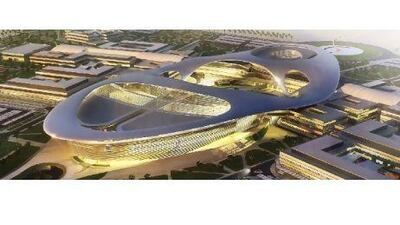"I like to engage with the objects of daily life," says the globally renowned architect and designer Hadi Teherani. "My smallest building is an aviary, and the smallest product I've designed is a pair of cufflinks for Montblanc.
"My projects extend from modular kitchens for Poggenpohl to high-rise buildings to Zayed University in Abu Dhabi; from a flagship store for Kiton to living bridges to the e-bike. I could also see myself designing a smart phone."
Teherani is part of a select group of "starchitects" whose brand extends beyond buildings to adorn everything from lemon squeezers to laptops. With a portfolio that includes interiors, lighting, floor coverings, wallpaper, door handles, sanitary ware, armchairs, sideboards, coat racks, office chairs, conference tables, kitchens and accessories as well as iconic buildings, Teherani prides himself on being an architect, interior designer and industrial designer all rolled into one.
The new Zayed University campus in Khalifa City is one of the most significant and challenging projects that he has ever worked on, Teherani says, because it was the first time that he was able to exercise this three-pronged approach on such a large scale. "It was the first time that - in a project of this dimension and depth - I was able to combine architecture, product and interior design. Besides that, a university of this size and importance, realised in such a short time frame and under such difficult conditions, is a very big challenge on its own. This is why I am very proud of this building, which will be opened in December."
The campus, which began operating in September but will celebrate its official opening in December, covers an area of 188,000 square metres and has a capacity of 6,000 students. The state-of-the-art facility consists of 28 buildings, including a 1,000-person theatre, a convention centre, 400 seminar rooms and a four-storey library with a tiered amphitheatre design based on the US Library of Congress. Dormitories offer everything from pharmacies to salons, and there is a childcare centre on campus.
Teherani's futuristic-looking design for the campus's main building is defined by a ribbonlike roof that sweeps over and then through the space. "The central functions of the university are formally interconnected in an organic way, inspired by the flowing forms of the desert as well as the veil," Teherani explains. "Functionally, shades creating exterior rooms activate communication. A roof like this has not existed before, especially not to these dimensions, covering several bigger building complexes and the spaces in between. The special allure and specific dynamic are the result of the roof not being an architectural element; it interfuses and creates the urban space."
Teherani started his career at the Technical University of Braunschweig. Unsure, initially, whether he wanted to study design or architecture, he tossed a coin and let fate decide - and this dual love of architecture and design has come to define his career. On graduating, Teherani launched his own fashion studio in Cologne as a sideline to his career in architecture, although he quickly realised that it was unrealistic to try to pursue both at such an early stage in his working life. "Architecture demanded such a significant amount of my time that it was hard to afford this passion along the way," says the Iranian-born German, who was in Dubai last week to speak at the Festival of Interior Design Congress. "The primary goal was to get established as an architect."
In 1990, Teherani founded the Hamburg-based BRT Architekten, Bothe, Richter, Teherani, with two fellow Braunschweig graduates. The architecture firm has designed industrial, commercial, residential, transport, public and retail buildings across the world. From there, the move into interior and product design was a natural one, Teherani says. "The work as an architect quickly made me into a product designer because I had to develop the specific solutions that I needed for my buildings, often on my own. At one point I realised that I was working across three channels - as an architect, as a product designer and as an interior designer. This was based on my objective, which I had followed unconsciously from the beginning, to harmonise architecture and design."
It is only when these elements are in complete alignment that an "ideal" space is created, Teherani believes. So in 2003, to complement his work at BRT, he established Hadi Teherani AG, a Hamburg-headquartered studio that focuses on interior and product design.
Teherani's approach to design - whether he is creating a cufflink or a university campus - centres on lebensfreude, the German joie de vivre. The focus of his creations is always the people using them, rather than products themselves and he is driven to create "a sensually inspiring living environment for humans; one that is harmonic, without all the distractions, simple and emotional; a lasting frame that leaves a lot of space and puts life into focus, not the design".
The greatest challenge, he says, is creating long-term solutions that are not "flash in the pan". For Teherani, sustainability is not restricted to materials and energy requirements; it is about creating products that fulfil their functional obligations and elicit an emotional response from their users. The key is "clarity of form" and "sustainable usability", he insists, and designers have a responsibility to build these features into their designs.
"In general, we have not yet reached a point where product design extends beyond fashion developments in every case. The temptation to be commercially successful with fast and short-lived products is just too big," Teherani concludes. "We have to get out of this habit of buying the same product five times before we find the right one. We have to convey the message to people that the bigger waste of money is to spend too little, because one will not get what one hopes for in return."


